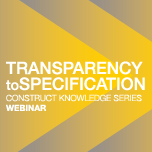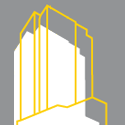
Function: Construct Knowledge Series Spring Webinar Listen to Part 1 of webinar from the download below Watch Part 2 of webinar by clicking HERE Transparency to Specification was a two-part Construct Knowledge Series webinar event covering how emerging trends such as Environmental Product Declarations (EPD) and Life Cycle Analysis (LCA) impact product specification. The discussion featured perspectives and insights from a diverse group of industry professionals who are experts in their respective fields. In addition to EPD’s and LCA’s, the discussion also covered other topics such as green product certifications, the progression of LEED, carbon footprints, embodied energy and other topics impacting how products are specified. Areas of discussion:• Green product certifications• How EPDs impact product specification.• Which design phase are LCAs considered?• Progression and impact of LEED• Carbon footprints• Embodied energy• Objective product comparisons• Greenwashing, ambiguous product claims Noteable Quotes from Webinar: Kate Simonen “It [EPDs] will grow to be an accepted or expected parted of good industry performance.” “EPDs and LCAs are really the international standard method of getting data and information from research to practice.” “EPDs provide a more transparent and technically robust method of reporting a product’s environmental impact. “Just because a product has an EPD doesn’t mean it is an environmentally preferable product. There is a lot of dialogue right now essentially alluding to the fact that if you have an EPD then you have a green product, and that not just the case. EPD is an equivalent of a nutrition label for food. Just because food has a nutrition label on it doesn’t mean it’s healthy for you. But if you read lots of nutrition labels you can understand that at certain times some foods are better for you than other times. There are many different criteria for nutrition labels just like there are many different criteria on an EPD. “ Derrick Teal “I think the whole point of getting an EPD is to show you don’t really have anything to hide.” “I think that once LEAD v4 is introduced you’ll see a lot more EPDs being specified or products of EPDs being specified…” Heather Gadonniex “Having an EPD at this point, particularly in North America, really demonstrates true sustainability leadership.” “They [EPDs] are easy to understand and they are credible, which I think adds a lot to the validity of the tool.” “If you are looking at product literature, there is no guarantee that those claims are third party verified. But if you have an EPD, there is essentially a seal of approval saying, ‘OK, this document has been reviewed by a third party program operator.’ Not only has the LCA been verified, but the actual content of the EPD has also be verified against the product category rules.” “The end user of the EPD encourages the use of more environmentally friendly and sustainable products, ultimately driving product development, innovation and the manufacturing process.” Francesca Desmarais “Without an EPD, architects and specifiers are in the dark about the comprehensive environmental and health impact of that product.”
: MORE Design With Conscience
A new trend in architecture has emerged – practicality. Architects and designers are creating buildings that cater to the needs and lifestyles of the building occupants. The design focus has shifted away from the elaborate on to the functional; away from a focus on prosperity and towards a sense of social responsibility. It’s called “humanitarian design.” On July 15, 2010 Function: hosted a webinar entitled “Design with Conscience: Humanitarianism in Architecture.” A panel of experts – including media, designers and industry specialists – focused on this emerging trend of social responsibility in architecture. Discussion included the changing thought process of product specification that has coincided with the new design trend and ways that Building Product Manufacturers (BPMs) can communicate their products correctly to ensure specification in humanitarian design. Conversation also focused on how BPMs can be thought leaders in this trend through providing product educational support for architects and designers on products that would be appropriate for meeting the needs of humanitarian design projects. Watch the webinar here, in four parts.
: MORE Media Webinar: Five Key Steps for BPMs to Boost Media Coverage
If you attended our recent Construct Knowledge Series Webinar "The Changing Face of Media Relations", you know there was an abundance of great advice and insight revealed to us by some of the top editors and publishers in the building and construction industry. And if you're familiar with the CKS, you know we typically record and send DVDs or post video or audio of the event online to share the information with those who could not attend live. In going through the transcript to write the executive summary, We realized how many great tips were divulged on communicating with the media in our industry. We have pulled from the transcript, the top five takeaways for those who either missed the event. Now, these are not ranked in any particular order of importance - and some may be basic but sound fundamental skills provide the foundation for growth and success. 1) Dive in, yes but look before you leap.This sounds really simple, but before contacting an editor/publisher, do your homework. Understanding the publication and its audience may be pretty basic but is often overlooked. To use an example from one of our panelists, “I had somebody ask me when the Green issue of GreenSource Magazine was.” Knowing which story types and topics are featured and who reads the magazine will help ensure you’re developing the best approach to pitch your story. 2) You can’t be articulate with your foot in your mouth.Know industry basics before attempting to speak about them. As Senior Editor from ED+C, Michelle Hucal lamented, “products cannot (and will never) be LEED certified.” You will discredit yourself and the company you represent by a lack of core industry knowledge such as LEED. We're not suggesting PR departments hustle out to get the new LEED Green Associate designations but it’s important to have that basis of knowledge so you can intelligently speak the industry language. 3) A picture…A thousand words. A hi-res image with your press release…Priceless.(To be read in your best Mastercard voice) Always include a photo with your press release. Whether its embedded, attached or linked, publications and their readers want to see quality images of projects. Not just photos of products – they want to see the product in action – in its application. And who did it. Where it was. How much it cost. Include as much information as possible about the project and the teams involved in creating it. Their readers and your company's customers want to know these things, so save a step by including these details upfront. 4) The transition from analog to digital isn’t just about cable TV.The vast majority of editors and publishers prefer email communications just like you. Email is more accessible and is much easier to share with a colleague than a package. When print samples and media kits are necessary, make sure it’s something your recipient hasn’t already seen. Two is not always better than one – editors don’t like duplicates! Finally, when sending flash drives, include a description of what it is. 5) Aint no party like verification from a third-party.Product specifiers can be apprehensive about claims made by BPMs. Ned Cramer, Editor-in-Chief of Architect Magazine cited that in a recent study conducted, "only 5% of architects trust claims made by BPMs." This painfully illustrates how important takeaway #2 is. We wonder how many architects out of the 95% who said they don’t trust manufacturer claims had a company rep tell them “our products are the only LEEDS certified on the market” ? This is where data from an independent research company (Function: can do this for you) or a seal of approval from one of the many new product certification companies can help. If you stand behind your products, back up your claims with research. It will help improve the credibility of your products and brands. And, if it’s a compelling enough piece of data, you’ll generate interest among the media and they might just cover that story about your new product launch.
: MORE The Changing Face of Media Relations: The Editors Tell All
Function: recently conducted a Webinar on the changing face of media relations. We brought in some of the most well respected and knowledgeable media experts in the AEC community. As Function:’s principal and director of strategy, Dana Castle, asked our panelists – editors from leading industry publications – about social media, Internet versus print, and emerging trends and tips for PR professionals, a lively discussion ensued. We were impressed and enlightened by the things these media experts had to share and we hope you were too. In case you missed the Webinar, here’s a recap on some of the important things we learned: Stories and Trends for 2010 Editors will push stories that appeal to their particular readership. Currently, these stories include the renovation/retrofit market; net-zero energy; and the fate of individual companies and practices during these hard economic times. Editors are still focusing on the “green” market and they noted that they’ve seen this particular market continue to grow and evolve despite the struggling economy. In fact, some of our panelists believe that green building will soon be mainstream. And, of course, Building Information Modeling (BIM) is still a hot topic. How Editors Prefer to Receive StoriesThis should be of particular interest to PR agencies as well as to the marketing departments of BPMs. Editors unanimously agreed that the best way to contact them is by email. Don’t Blind Copy (BCC) or Carbon Copy (CC) a bunch of people to the same email, they say, and be sure to include as much information as possible – facts and figures, relevant photographs, etc. – so they have everything easily accessible. Follow-up calls after an email are welcomed and appreciated. As far as media kits and paper copies, most editors say not to bother sending them. And if you do send them, never send something that you’ve already sent- they’ll just throw it away. Make sure that the information you are including in a media kit is new and relevant. A few of the editors suggested putting a media kit online and then handing them a card with the link and password. Publishers do depend on info from PR professionals and truly value trusted relationships. However, they say that most readers lack confidence in claims made by Building Product Manufacturers (BPMs), so it is ideal when PR professionals can supply research and statistics from reliable third party sources. Changes in the Media Based on the InternetThe evolution of the Internet has changed the way publishers reach their audience. Print and Web content are now complimentary tools. Although some editors’ value one over the other, they all agree that print content is shrinking and Web content is growing. Changes in the Media Based on the EconomyThe economy has also contributed to decreasing content in print editions of publications and more content online. Print, as the more expensive medium, is often the first to go. This means there are less places for stories in print publications, but our panelists noted that they are receiving more stories than ever. With less space and more competition, BPMs face a decreased chance of being featured in print (online, however, is growing). And finally, the economy has affected everyone’s ability to attend trade shows. Publishers are opting to go to more local shows and for letting a closer representative attend shows that are farther away. Changes in the Media Based on Social MediaSocial media has also transformed the relationship between publishers and their readers. Publishers now have a direct connection to their audience and direct field contact. Editors use a variety of sites: LinkedIn (for business purposes), Facebook (for “fun” purposes), Twitter and blogs. Some publications have latched onto social media more than others. Those that have experimented with social media say that it has been helpful, but admit they still have much to learn. And they plan on learning more, aware that the presence and use of social media is growing. Some editors are skeptical about the usefulness of social media in this industry and advise BPMs evaluate the usefulness of social media for each of their unique needs. Extra Advice for BPMsEditors see trends moving in such a way that BPMs need to start using BIM regularly and hiring consultants who truly understand the technology. These editors also suggested that BPMs join cultural or academic associations to increase their exposure to the public. But, like the advice they gave pertaining to social media, editors suggest BPMs only worry about joining associations that are beneficial to them and relevant to the work that they do. So there you have it – a look at the changing face of media relations. We are grateful to our media experts for providing information on upcoming trends, and tips for adapting to these changes.
: MORE The Changing Face of Media
How can I reach media through new outlets? Is social media really effective? What stories will media be talking about in 2010. This webinar is designed to answer those questions and more. This webinar featured a panel of editors and publishers from some of the most influential publications in the arcitecture, engineering and construction industry. By listening to the discussion, you will understand the growing importance of earned media and its place in the marketing mix, as well as how to use public relations more effectively to achieve your marketing and sales goals in the coming year. Recording will be posted soon. Please check back.
: MORE How Tweets, Posts and Friending Can Benefit the BPM
Facebook, Twitter, LinkedIn and blogs have evolved into some of the most important communication tools in the business world. To address how Building Product Manufacturers can use Social Media to connect with their audiences, enhance their brands, and ultimately increase sales, Function: hosted a Webinar featuring a panel of industry experts.
: MORE BIM: Opportunities, Challenges and Strategies for the BPM
The BIM Webinar is now available for download. Click here to listen in as we connect with industry experts to discuss the impact of BIM on the Building Product Manufacturer, the sales cycle, how BIM contributes to green building and more. For an executive overview highlighting key points from the webinar, please contact Dana Castle: [email protected]
: MORE Construct Knowledge Series Session Reveals Architects are Moving Toward an Integrated Design Approach to Green Building
Function: hosted its quarterly Construct Knowledge Series session and found that architects and industry experts think green building is moving beyond individual products and into an integrated design approach with the objective of achieving very clear environmental goals. The roundtable featured a diverse group of professionals with backgrounds in architecture, design, engineering and contracting. Discussion topics ranged from sustainable building practices, industry trends and challenges, Building Information Modeling (BIM) and useful technologies, to the Architecture 2030 challenge and more. “As the market continues to evolve, we have found it is critical that our clients understand the latest industry trends, and more importantly their target audiences, to remain competitive,” said Dana Castle, principal and managing partner of Function:. “The Construct Knowledge Series allows us to gather information from industry leaders and experts that can help our clients in not only better reaching their target audiences, but in developing strategic programs to increase their brand recognition.” Architects, designers, engineers and contractors are major influencers in the building and construction industry. The Construct Knowledge Series is a unique opportunity to gain direct feedback from these key influencer segments and gain a deeper understanding of the issues of importance to these industry experts. Panelists for the 4Q Construct Knowledge Series session included: Dennis Creech, Southface; Brad Higdon, BDR Partners; Jason McFadden, Barton Malow; KP Reddy,RCMS; and Susie Spivey-Tilson, TVS. Highlights from the session include: Sustainable Practices: Although there has been an increase in green building, (more than 10 percent of new commercial buildings in the United States are registered to become LEED certified according to Creech), panelists think there is still a long way to go to fully meet the potential that green building has to offer. Panelists agreed that the first step in getting green building where it needs to be is education. While many building owners have begun to identify that a project needs to be sustainable or achieve a certain level of LEED certification, they do not fully understand what that means to the design and construction teams and ultimately the operations group for the facility. Industry Trends and Challenges: Although the economy continues to decline, panelists think that green will positively affect the economy. During the recent presidential election, both candidates discussed the important role that energy efficiency can play in reinvigorating the economy. Very often architects and designers find it challenging to sell green to clients and to get them to consider costeffective energy upgrades. BIM and Useful Technologies: Building Information Modeling’s (BIM) biggest impact will not be its 3-D modeling, but its data analysis capability and the ability to monitor a building’s performance data to analyze the projected model’s energy performance versus actual performance and make adjustments in design based on these findings. For manufacturers, BIM presents an opportunity to become involved in the design process. Products are moving from the catalog or database into the model, which could lead to an increased customization of products based on the application. Panelists think that BIM is a template for integrated design. According to panelist, KP Reddy, “BIMis going to change the design community’s view of the deliverable. Rather than the deliverable being a set of drawings and specs, the deliverable becomes the building. Once you get everybody focused the end game being the building, it makes a difference.” Product Specification: Specifiers receive product information through numerous outlets – lunch and learns, marketing brochures, direct mail, sales calls, and more. Panelists agreed that when it comes to sourcing products it is essential that a building product manufacturer be able to answer technical questions about their product and provide clear, concise information. Specifiers want to know that manufacturers are knowledgeable about their product and not reading off a brochure. The more specific information and data a manufacturer can provide, the better chance they have of getting their products sourced. In addition, third party validation is becoming increasingly important. Architecture 2030: There have been an increasing number of groups adopting the American Institute of Architects’ (AIA) 2030 challenge. However, many questions remain as to how to best get from the building designs of today to the opportunities of tomorrow. Panelists agreed that meeting the 2030 challenge is achievable, but it is essential that building owners and decision makers are committed. In addition, panelists think that addressing the issue of climate change is another key element to achieving the challenge. According to Creech, buildings in the U.S. contribute approximately 48% of the greenhouse gases that drive climate change. The building industry influences nearly half of the greenhouse gases that the U.S. produces. By addressing energy use in buildings, the 2030 challenge is attainable. “Green is selling and we are witnessing an unbelievable transformation across the design and construction industry,” said Dennis Creech, executive director of the Southface Energy Institute. “As the industry matures, and green continues to drive product development, we find that we are getting away from a green building being an assembly of green products. It’s really an integrated design approach. The goal is not, ‘how do I put 13 green products in this building?’ but ‘how do I get a high-performance, energy-efficient building, that’s durable, budget-friendly and will be flexible over time?’ I think that is the challenge we have as an industry - moving beyond individual products into this integrated design approach.” To find out more about the topics discussed during Function:’s Construct Knowledge Series session please visit www.functionatl.com.
: MORE